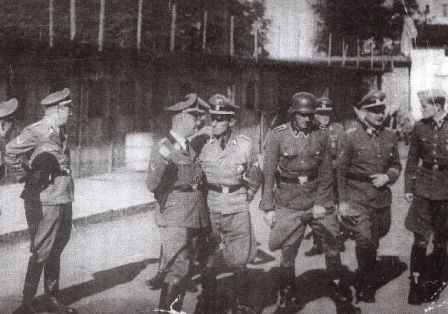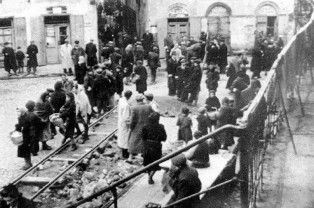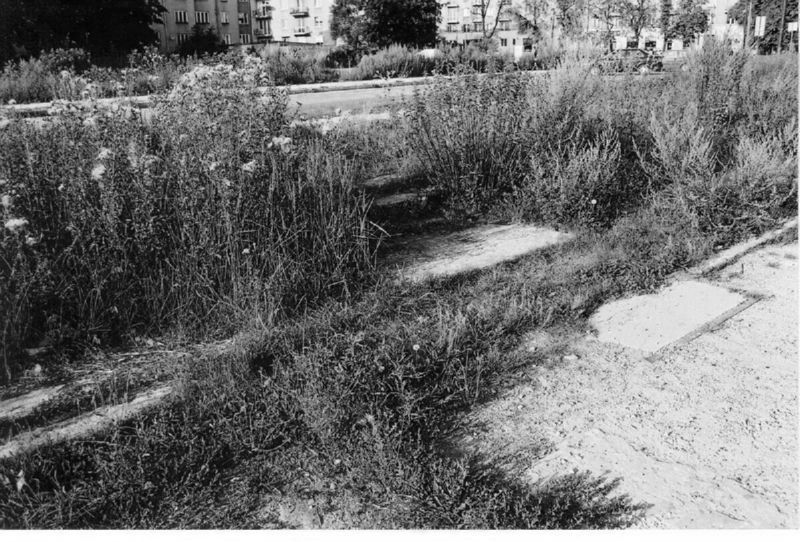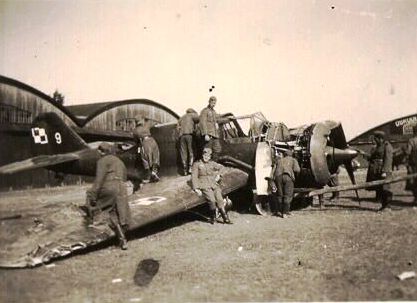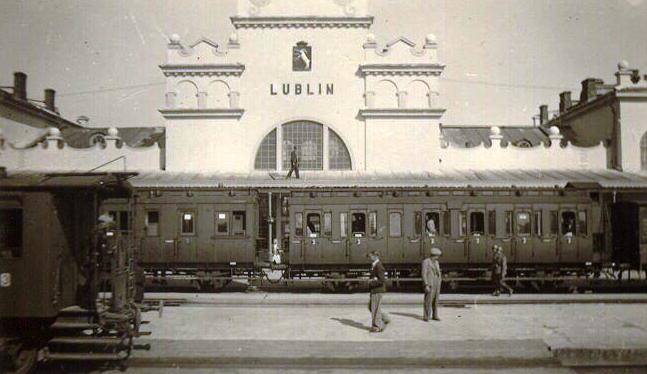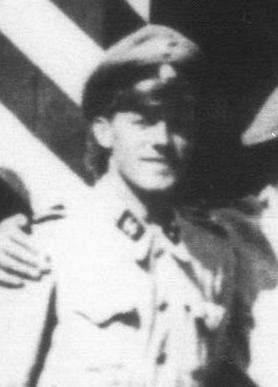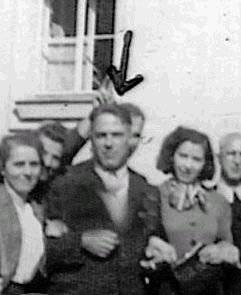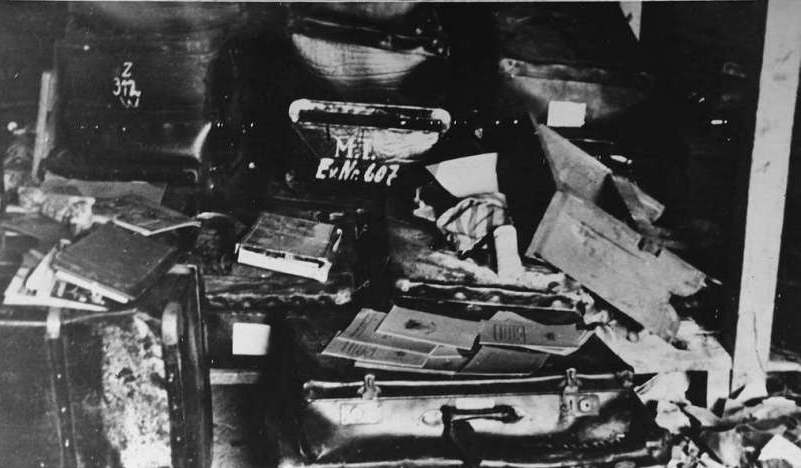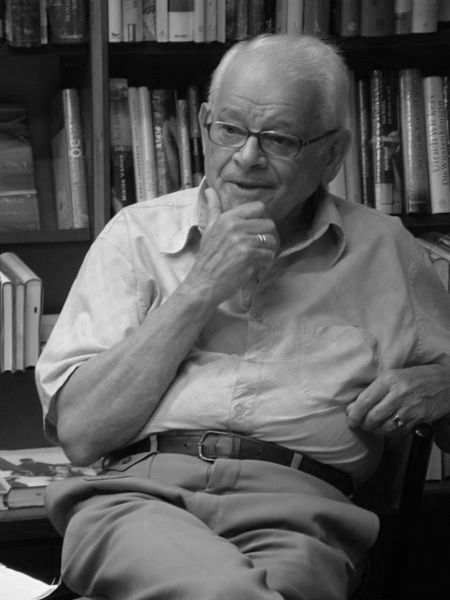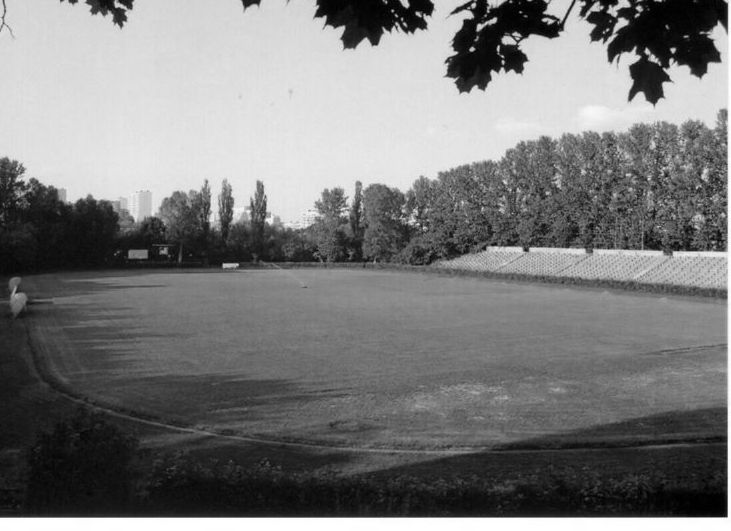Holocaust Education & Archive Research Team |
Ghettos
Lublin Introduction to the Ghettos of the Holocaust
Jewish Ghettos The Judenrat Judenrat Leaders Prominent Jews
| ||||||||
Lublin – The Labour Camps
7 Lipowa Street Camp
The labour camp at 7 Lipowa Street in Lublin, the first in the Lublin district, was established on Globocnik’s initiative in December 1939.
During the war this street was renamed Lindenstrasse by the German authorities. After a number of buildings had been erected, the SS and police opened there a number of craftsmen’s workshops in which skilled Jewish workers were forcibly employed.
Initially, these were local craftsmen who lived in their homes and reported to work each day. In mid-1940 about 1,200 workers were incarcerated in the camp, but they were released at the end of the year and replaced in December 1940 and January 1941, by about 2,500 Polish army soldiers of Jewish extraction – brought from Prisoner of War camps in East Prussia.
In that period, the camp also served as a penal camp for the Polish population who failed to fulfil the economic obligations imposed on them by the Nazi authorities.
Thus in January 1941 as well as the Polish – Jewish Prisoners of War 192 Poles were also imprisoned in the camp, although in time the latter were released.
In December 1940, the workshops were taken over by the Deutsche Ausrustungswerke (DAW) company, which had extended the scope of its activity. The Jewish prisoners and the Prisoners of War incarcerated in the camp during 1941 and 1942 were trained in various building trades. They worked on the expansion of the camp and, as bricklayer, plasterers etc at various jobs in Lublin.
In the autumn of 1941, when the SS and police began establishing a camp in Majdanek, several hundred POW’s were detailed to erect a fence around it. At the same time, the camp in Lipowa Street was subordinated to the commandant of the KGL Lublin. Due to disputes, between the manager of the company workshops and Karl Koch, in mid-1942 the administration of the camp was taken over by Globocnik the SS and Police Leader of Lublin
In 1942 the rapidly developing DAW company opened a tar-paper factory on the premises of the former airfield in Chelmska Street, and the next year it set up shoe repair shops, launched the production of shoe soles and munitions boxes. The Lublin branch of DAW was divided into three establishments located in Lipowa Street, in Chelmska Street, and in Pulawy, where a sawmill was situated.
In the autumn of 1943 there were 2,500 prisoners in each of the first two establishments and 486 prisoners in the third. Witnesses to what happened in Lipowa Street camp, are scarce, so the memoirs of one Jacob Frank, who was at the camp from its inception to virtually the end of its operational life.
Frank was the SS- designated supervisor of the camps important tailoring division and was in charge of some 475 workers, though not all were qualified tailors. It was SS- Untersturmfuhrer Horst Riedel who advised the Lublin Judenrat, that tailoring workshops were to be erected on the expanse of land at Lipowa Street.
This order meant that Lublin’s Jewish community had to first collect the necessary tools of the trade, as well as provide the workforce to build the camp. The tailors and later Jewish shoemakers had to provide their own sewing machines, scissors, irons, needles and so on to run Riedel’s proposed workshops. Riedel for a short time was commandant of Lipowa Street camp.
Frank recalled that Globocnik was clearly proud of Lipowa Street camp, because he regularly showed its workshops to visiting Nazi dignitaries, on the 20 July 1941, including Heinrich Himmler, Friedrich- Wilhelm Kruger, Heinz Kammler
Lipowa Street Camp first came under the control of SS- Standartenfuhrer Walter Gunst, who was quickly followed by Ludolf von Alvensleben, a member of Lublin’s Selbstschutzfuhrer but who handed the day to day management of this important camp to SS- Obersturmbannfuhrer Hermann Dolp, who lasted in the post until June 1940.
From August 1940 the camp was commanded by SS- Untersturmfuhrer Horst Riedel and his adjutant SS- Untersturmfuhrer Wolfgang Mohwinkel. Riedel concentrated on making business deals, which led to the economic success of the camp, while the restless, arrogant Mohwinkel implemented a brutal regime of discipline, including beatings, hangings and shootings.
In February and March 1941, the camp’s business and economic planning were taken over by the German company – Deutsche Ausrustgswerke, which in reality this company was an SS subsidiary headed by Riedel and ultimately controlled by Globocnik.
In November 1941 Globocnik relieved Riedel of his command of Lipowa Street camp and the highly dedicated Mohwinkel took over as commandant until 3 November 1943, when the Aktion Erntefest murdered all the Jews who worked in the camp.
On 17 August 1942 several hundred inmates were selected for transfer to Majdanek but the shoemakers amongst them used their knives to attack the guards, killing and wounding some of the guards.
The SS shot and killed the attackers, whilst the remainder were taken to Majdanek. During the camps existence a resistance organisation was active, led by Roman Fiszer. Little by little about 400 Jews were able to escape during the winter of 1942/43. Most of them were caught and shot, but about 150 reached the forests and joined two underground groups which later became part of the “Gwardia Ludowa” partisans.
On 3 November 1943 the last 2,500 Jews were marched from the Lipowa Street camp to Majdanek concentration camp to be shot, as part of the Aktion Erntefest massacre. Some of the Jewish prisoners tried to escape, but their efforts were not successful.
Jacob Frank survived the Erntefest massacre, just before the mass executions took place Frank was transferred to the prison in the Castle, because he was working on a leather coat for Odilo Globocnik, who had left Lublin to become Higher SS and Police Leader Adriatic Coastal Zone, based in Trieste.
Frank recalled the prison commandant SS- Obersturmfuhrer Domnik, originally from East Prussia called for his new prisoner to be sent to him – After a few seconds he told me “I have an order from SS- Gruppenfuhrer Globocnik to help you here, and here you are safe. But I have also a package, I am sure you have this upstairs. This is the coat for the Gruppenfuhrer and we have a shop with tailors. I set up a place for you and if you need any help, you must tell me, and I will give you all the help you want from the other tailors, who are there in the prison with you.”
Frank was subsequently transferred to Radom, to another labour camp, then as the Russians advanced to the concentration camp at Auschwitz, and then Natzweiler where he was liberated.
After the mass executions of all prisoners the production was discontinued. On the basis of Pohl’s order of 13 January 1944 concerning the resumption of production 500 prisoners skilled in various trades, were brought from Dachau, Buchenwald, Sachenhausen and 160 prisoners were brought from Majdanek.
They represented 18 nationalities, mostly Germans, Austrians, Frenchmen, Poles and Dutchmen. Upon the re-opening of the camp it was subordinated to Majdanek as a branch and was operated in this capacity until the 22 July 1944, when the prisoners were evacuated to Auschwitz, as the Red Army was approaching Lublin.
The former site of the Lipowa Street camp has now been completely been built over, by an entertainment complex.
The Old Airfield Camp
The SS Clothing Works(SS- Bekleidungswerke) was established in the summer of 1941, on the premises of the former Lublin Aircraft Factory, the so-called Plage and Laskiewicz Mechanical Plant located on Chelmska Street.
Initially women prisoners from the Lublin Castle and Jewish specialists from the Lublin ghetto were employed there. Production was developed on a large scale, because Himmler in a note dated 21 July 1941, instructed the SS storehouses to place their orders there.
In effect, the enterprise was subordinated, as of 1 September 1942, to the SS- Clothing firm as a branch. This situation lasted until March 1942, when the Clothing Works was again placed under Globocnik’s administration.
Thenceforth, the enterprise was to engage in the segregation, disinfection, and shipment to the Reich of the property of the murdered Jews, in the death camps of Aktion Reinhard.
In connection with this re-organisation and in order to conceal the true nature of the Works activities, SS- Hauptsturmfuhrer Friedrich Opitz was replaced as the works manager by SS- Hauptsturmfuhrer Josef Obermeyer, Globocnik’s trusted right-hand man.
His task was to expand, from the spring of 1942 till the spring of 1943, both the Clothing Works proper and the prisoner barracks. In the newly erected barracks Jews and Jewesses were accommodated.
Just before Christmas 1942 Christian Wirth the former Belzec death camp commandant and since 1 August 1942 the Inspekteur der SS- Sonderkommando moved into a two-storey villa on Chelmska Street, at the north-west corner of the disused Lublin airfield, and adjacent to the main Lublin- Warsaw – Lvow railway line.
The ground floor rooms were used as offices – staffed by Wirth, Oberhauser, Hausler and a couple of secretaries. On the first floor were located a first-class dining room and living quarters for Wirth and his staff.
Here at the old airfield from the commencement of the mass-murder programme three hangers had been used as the main sorting depot for the great heaps of clothing, belongings and valuables taken from the victims of Aktion Reinhard.
About 2,000 prisoners – predominantly women – were employed in sorting the plunder. The articles of clothing were sorted on arrival into kinds – men’s, women’s and children’s. Then sorted again into outer and under –wear, types of footwear. There were also big crates into which were deposited the gold, the silver, diamonds, pearls, gold watches, and other valuables.
At the end of each day, up to six men were needed to carry each crate to the Kommandantur. A great deal of the accumulated wealth was pilfered daily.
Oberhauser who worked at the Kommandantur recalled that:
“The unregistered jewellery and valuables from the individual death camps were delivered to the SS- Verwaltungsamt, whose head was SS- Sturmbannfuhrer Georg Wippern. I had not the slightest thing to do with this.”
In 1942 the DAW Company opened a tar-paper factory behind Wirth’s villa and beyond that a railway siding led from the main tracks into the depot. The wagonloads of plunder from the death camps arrived at the siding and after unloading, sorting and cleaning were despatched again by rail to the Reich.
This too was one of Oberhauser’s responsibilities:
“At the office on the airfield I was Wirth’s representative insofar as he was responsible for the supervision and welfare of the Jews employed in the clothing workshops. I had the task of organising the transports of materials being taken away, and looking after the arriving transports of materials.”
The loading work at the railway siding was carried out initially by 20 Polish- Jewish Prisoners of War from the DAW labour camp on Lipowa Street in Lublin. They were supervised by SS- Rottenfuhrer Ernst Gollack, who also supervised the disinfection of quality clothing.
“Furs and skins from the Jews at the Belzec, Sobibor and Treblinka extermination camps were disinfected there and sent to Germany. These articles arrived by rail in goods wagons, were unloaded by the “Hiwis” – and later on unloaded only by work-Jews – disinfected and re-loaded into the goods wagons. (Hiwis – German term used for Russian volunteers). I was employed at the clothing depot as a disinfector and was in charge of about 20-30 Jewish women who were also trained as disinfectors.”
The disinfection work was carried out in a segregated section of the depot in special chambers using Zyklon – B, a special preparation of hydrocyanic acid. These chambers were also used on occasions to kill prisoners no longer fit for work. With the arrival in spring 1943 of SS- Hauptscarfuhrer Lorenz Hackenholt, the Belzec gassing expert, there can be little doubt he was active in the gassing of these prisoners.
In the spring of 1942 the airfield was divided into a men’s and a women’s compound, segregated by a high plank fence with the entrances at opposite ends.
The prisoners’ work day lasted from 0800 – 1800, with a midday break, according to SS-Sturmbannfuhrer Georg Michalsen of Globocnik’s staff:
“The camp management was in Jewish hands – there was a Jewish camp police, and in addition in certain circumstances those Jews who had special passes could buy goods they needed in Lublin and its environs.”
Until the arrival of Wirth and his staff, the camp had been run by SS - Hauptsturmfuhrer Josef Obermeyer, assisted by his deputy Heinrich Birmes. Wirth and Obermeyer took an instant dislike to one another, Wirth did not approve of the way the camp was being run, and Obermeyer loathed the way Wirth treated the Jewish workers.
Wirth was very much feared by the Jewish workers, because of his penchant for riding round the camp on horseback – even entering the barracks and workshops – brandishing a whip on which there was a piece of barbed-wire, according to the statements of Ernst Gollack..
SS- Oberscharfuhrer Bauer from Sobibor death camp who visited Wirth at the Old Airfield witnessed an example of Wirth’s brutal treatment of the Jewish workers at the tar-paper factory.
Wirth was personally supervising the work:
“I myself have seen and remember for certain how the Jews employed there were pouring fresh hot tar onto the pasteboard with bare hands. I also saw the raw flesh peeled from their fingers so that the bare bones could be seen. I am convinced that all these people died of their bad burns. I remember this work with the tar-paper so well because I was upset by it at the time and Wirth hit me in the face with his whip.”
Wirth began re-organising the camp at the end of December 1942 by sending all the male prisoners to the nearby Majdanek concentration camp, and re-naming the depot – The Used Materials Administration Depot of the SS Administration Office Lublin, thus bringing it directly under the control of SS- Sturmbannfuhrer Georg Wippern.
Wirth then personally selected a new Jewish work-force from the next incoming transport according to their skills. The selections were carried out on the main railway tracks just outside the depot, the remainder of the transport Wirth sent on to Majdanek camp.
Selections were frequent and this account from the unpublished memoirs of Wieslaw Dobrowolski describes one such selection:
“Every fortnight – sometimes more frequently – a selection was carried out in the camp. On such occasions a group of SS- men arrive from Majdanek to conduct the selection. We had to line up on the asphalt road.
On the same road, about 50 meters away from us, right by the main entrance to the camp, the group of SS-men gathered. At a sign from the SS-men, 3 -4 prisoners were ordered to run towards the gate. The men who ran tolerably well were placed on the right of the road, while those whose legs refused to carry them properly were ordered to stand on the left.
There were always a few dozen who were sorted out and escorted to barrack number 5. This was the so-called “gas barrack” which served as a disinfection chamber for furs. The people selected were gassed in this barrack. I was a witness when Wolanow, the very popular owner of an office selling State Lottery tickets, was selected and pushed into the “gas barrack”.
The shrieks and cries spread far and wide beyond the “gas barrack”. When Wolanow’s 17-year old son, who was standing nearby, heard the cries he was seized by a fit and cried spasmodically.”
The old Lublin airfield was also used throughout Aktion Reinhard as a mustering cente for personnel transferred from the euthanasia institutes in the Reich- members of the SS, police, male nurses – to staff the Aktion Reinhard extermination camps in Poland.
They were usually met by Wirth personally, on occasions accompanied by Reichleitner from Sobibor and Stangl from Treblinka. According to witnesses, at these personnel selections, all three commanders wore the uniforms of Schutzpolizei officers, and none of them mentioned anything about which units they were joining, or where they were to be based.
The male nurses among them – referred to now by Wirth and others as “civilians in uniforms” were first sent to the SS training camp at Trawniki, near Lublin, on a two-week basic military training course.
Between January 1943 and spring 1943, a number of Aktion Reinhard personnel were transferred from the death camps to serve at the old Lublin airfield, either because they were now redundant, or as a disciplinary measure.
Among the disciplinary cases were SS- Oberscharfuhrer Kurt Bolender from Sobibor and SS- Stabsscharfuhrer Otto Stadie from Treblinka. Bolender was attached to Lorenz Hackenholt’s work-brigade, and Stadie was placed in charge of the 120-strong Trawniki –SS guard unit at the old airfield.
In February 1943, following the establishment of Ost- Industrie GmbH (Osti) – East Industry Company, the company managed by Globocnik to utilise Jewish labour, was again subordinated to Globocnk, as the director of the company until its liquidation on 3 November 1943.
Jakob Sporrenberg who took over from Globocnik as SSPF Lublin described a visit to the airport camp, during a post war interrogation. “A second branch of the DAW, together with OSTI, were housed in a very large camp at the airport. To visit this camp Sporrenberg had to get permission from Globocnik’s office.
Here the goods produced were brushes of all kind, shoes with wooden soles, and other articles made of wood. Globocnik himself was managing director and as it was not paying its way, efforts had been made to produce parts for aircraft.
Sporrenberg realised things were not in order. There was a “special task unit” with its headquarters on the airfield. Its commandant was Sturmbannfuhrer Wirth, who was also Globocnik’s deputy and acted on his behalf after his departure to Trieste. This man, of great physical stature, presented himself to Sporrenberg with a whip in his hand.
Sporrenberg says he objected to this. There seems to have been more living space in the airport camp, and it was well equipped in other respects. The sick bay was run by Jewish doctors, dentists and nurses, but there were only a few cases of sickness. From a Jewish doctor Sporrenberg learned that however many privileges the Commandant Wirth might grant, he could not account for his cruelty on other occasions.
Before leaving, Sporrenberg advised Wirth to treat prisoners justly and fairly, and train and advise his men on the same lines. Wirth informed him that Globocnik himself would return before long in order to “dissolve” the camp and that Globocnik had been charged by Himmler with the special task of settling the Jewish problem throughout Europe.”
On the 3 November 1943 the old airfield site was cordoned off by SS and Police forces, including members of Police Regiment 25, which included members of Police Battalion 101, and the prisoners marched the short distance to nearby Majdanek concentration camp where they were shot in specially prepared ditches, behind the new crematorium.
The camp was liquidated on this day, and Wirth joined Globocnik in Italy. One of the few survivors from the Alter Flugplatz told his story.
Jules Schelvis at Alte Flugplatz Lublin
Amsterdam born Jules Schelvis (* 1921), -seized from his house on 103, Nieuwe Kerkstraat near the ‘Meagre Bridge’ over the Amstel River, in a big round up on 26 May 1943,- was deported to Westerbork that same day, and from there to Sobibor on 1 June. Three days later his wife Rachel, her parents and sisters were gassed there on arrival. Jules was selected in the Sobibor reception area to work in the peat diggers camp at Dorohucza on the River Wieprz.
After nine days in Dorohucza, he and two other Dutch Jews, -Joop Wins and Leo de Vries,- were selected again, because of their knowledge of the German language, and sent further to the Alter Flugplatz (Old Airfield) camp, between Lublin centre and KZ Majdanek, south east of the city.
But instead of work in a printing office, as they had been promised, they were forced to help building new barracks for prisoners. SS men whipped the slave labourers all the time, shouting: “Schneller, schneller, prentko, dalli dalli”.
Living conditions in the camp were almost indescribable. Hordes of lice covered the mattresses and everywhere in the sleeping barracks were heaps of human excrements.
Some of the exhausted slave workers lay dying in the bunks, no longer aware of anything; the so called ‘mussulmen’. The food consisted of little more than brown water (‘soup’). Inmates sold or exchanged everything they had for extra food: e.g. one’s pants, belt or a knife for a piece of bread and some butter, somehow smuggled into the camp. A loaf of bread cost 350 zlotys, 50 grams of butter 50 zlotys.
The prisoners were tortured in a very sadistical way. At the Appellplatz, on the command “Mützen ab! Mützen auf!” they had to take off and put on their caps simultaneously. When the SS officer was not satisfied with the result, the prisoners were beaten and those who could not keep up to speed, were forced to do all kinds of gymnastic exercise. Whips and rifle butts were used to speed up the victims. The other prisoners had to watch the scene.
They were also forced to watch the hanging of two inmates who had tried to escape; a young Pole and the Dutch Jew Jim Kleerekoper, who had been forced to build up their own gallows. This “ceremony” was supervised by SS Untersturmführer Wolfgang Mohwinckel, sitting proudly on the back of a white horse. The hangman was a Volksdeutsche by the name of Schmidt. [Mohwinckel was rewarded with a Kriegsverdienstkreuz by the Führer, but sentenced to life time imprisonment in 1974. ] The following days Jules and the other men from Dorohucza were sent to the hall of a former radio factory, to clean machines. There, the prisoners possessed a Russian radio which broadcasted Soviet military news.
Sometimes men in the radio factory were commanded to the building sites or to demolish old barracks. Jules’ friend Joop Wins, also a member of the Dorohucza printers group, found a $ 20 bill, hidden behind a loose shelf. One US dollar had a rate of 600 zlotys in the camp at the time. This fortune kept the group in better condition during several days.
On the 14th day of their stay at Alter Flugplatz, 27 June 1943, the camp was visited by a man named Seifert, commander in the OSTI-organization. He was accompanied by Marian Winogrodski, a Jew, who was to take command of the SS printing office in the town of Radom. One hundred men from the Alter Flugplatz camp were selected for this office, including the three Dutchmen. Most of the others were Jews and Jewesses from Warsaw. The next day they were put on the train consisting of two freight wagons, to Radom.
… and how he survived the Holocaust.
Jules Schelvis stayed in the printing office in the Radom ghetto until early November 1943, when he was interned in a new nearby camp at Szkolna. There he stayed until 26 July 1944.
A march to Lodz (Litzmannstadt) was planned, but at approximately ¾ of that distance at Tomaszow, the survivors were put on a train to Auschwitz. At the famous Rampe Jules was selected again for slave labour, this time the building of a secret underground Messerschmidt airplane factory of Organisation Todt near Vaihingen an der Enz in southwestern Germany, -originally an Außenlager of KZ Natzweiler in the Alsace,- where he arrived on 12 August 1944.
In November 1944 Jules was sent to a camp in Unterriexingen, 10 miles from Vaihingen and some 20 miles NW of Stuttgart. In Unterriexingen he got ill with a foot infection and taken into the infirmary barrack; there he was infected with typhus. Jules was evacuated from Unterriexingen in March 1945, although not to Dachau with the prisoners considered still able to work, but back to Vaihingen, which meanwhile had been converted into a recovery camp (“Erhohlungslager”). There he was liberated on 8 April 1945 by French troops, exactly one month before the capitulation of Nazi Germany.
Leo de Vries and Joop Wins had been together with Jules as “die drei Holländer” almost until the end. The two were put on a transport from Unterreixingen to KZ Dachau, which in fact took weeks to arrive there. Leo died during the transport. Joop survived Dachau and was reunited with Jules in Amsterdam in early July 1945.
Sportplatz Camp
Wieniawa a suburb of Lublin’s population was predominantly Jewish about 75% of the population. It was an old Jewish community established in the 17th century, with its own synagogue and cemetery.
During World War One this community and the entire suburb were incorporated into the city of Lublin, although very close to the elegant centre of the city, was very poor. The dwellings in the main consisted of wooden houses. The largest building was the synagogue erected in the 18th Century which was situated exactly in the centre of the suburb.
When Lublin was captured by the German Army, Wieniawa located in the streets neighbouring the German administration district, was incorporated within the German district.
Jews were no longer allowed to live there and in March 1940 the entire Jewish population of Wieniawa was resettled in the Lublin ghetto. From that time groups of Jews from Lublin were led to Wieniawa in order to demolish the houses vacated by the Jews.
According to plans drawn up by Odilo Globocnik SS and Police Leader Lublin the suburb was designated to be an area for the building of recreational facilities for the SS and police and the general German population of Lublin.
The first construction work was undertaken during 1940 and 1941. The Jewish cemetery was totally destroyed and the tombstones were used for building material in the German district. Some of these tombstones were discovered in 1994 during renovation work, and were relocated in the New Jewish Cemetery in Lublin.
In 1941, the SS began to build a sports stadium and swimming pool on part of Wieniawa’s former Jewish cemetery. The forced labourers who undertook this work were Jews from the Lublin ghetto and according to some testimonies a group of French Prisoners of War, who were located in one barrack on Leszczynskiego Street.
From its inception, the site of the work-camp was called the Sportplatz (Sports field) by both the Germans and the prisoners. In the spring of 1942 with the commencement of Aktion Reinhard, a regular work camp was established on Ogrodkowa Street close to the Sportplatz.
It is unclear whether, from its inception, the prisoners housed in this camp consisted solely of Jewish prisoners who were taken from the Majdanek concentration camp, or they were selected from the Lublin ghetto, during the deportations to Belzec death camp.
The main building of the camp was located in the former cosmetic factory, which had been confiscated by the Nazis from its Jewish owners, and Jews were led there every day from Majdanek concentration camp.
The factory belonged to the engineer Roman Keindel, who before the war was the owner of the famous Lublin cosmetic company Erika. During the war, Keindel, although no longer the owner of the factory, still worked there as the principal specialist. From the time of the establishment of the camp, he was the Lagerkapo at the Sportplatz camp.
The factory was in the largest of the buildings, and from the spring of 1942 it was surrounded by barbed-wire. The prisoners worked and slept in the same building, and the SS guards were also stationed there.
At the end of 1942 additional barracks were built near the factory building, and it was only after they were built that a permanent group of the prisoners lived there.
The Sportplatz became a sub-camp of Majdanek and was designated SS- Polizeifuhrerkommando Sportplatz. In 1942 the prisoners numbered approximately 600 people in total.
Because of the lack of survivors testimony, first hand sources about conditions in the camp do not exist, but according to some testimonies the prisoners who were at the Sportplatz had greater possibilities of contact with Poles, from whom they bought food.
Groups of Jewish Prisoners of War from the Lipowa Street camp were also brought to the Sportplatz every day, and some fellow prisoners had the opportunity to exchange information and food with them.
The other part of the Sportplatz – the cosmetic factory building – had a direct connection to Aktion Reinhard. From the beginning of 1942, the normal production of cosmetics was abandoned.
The building was thus converted into a special store for cosmetics, medication and surgical equipment. These items had been confiscated either during the liquidations of the ghettos in the Generalgouvernement or directly from the bags and suitcases belonging to the victims of Belzec, Sobibor, Treblinka and Majdanek.
Artificial limbs were also gathered here, repaired and dispatched. According to the sole survivor of the Sportplatz camp Dora Minc (Julia Celinska) – it was a very large factory in which all of these things were segregated and utilised. Some of the confiscated items were transferred to German Army hospitals in Lublin, the remainder was sent to the Reich.
The commandant of the camp was SS- Standortarzt Sturmbannfuhrer Dr Kurt Sickel who Dora Minc considered to be a liberal person. The individual though who played a major role in the camp was Mrs Radischat, who had an affair with Globocnik, and was also the lover of Dr Sickel.
She supervised the prisoners in the factory and also participated in the plunder of Jewish property – she was regarded as very cruel to the prisoners,
The Sportplatz camp existed until 3 November 1943, when it was liquidated during the Aktion Erntefest massacre, the number of prisoners murdered is not known.
According to Dora Minc there was a resistance group among the prisoners in the factory. They were preparing for a mass escape from the camp at the moment of its liquidation. The leader of this group was Roman Keindel, who had connections with the Polish resistance.
Due to his contacts with the Poles, he was able to organise hiding places in Lublin for the group of would-be escapers. However, the liquidation of the camp was planned by the Germans in secret, and nobody from the group were able to escape. Early in the morning, trucks arrived on the Sportplatz and all of the prisoners were loaded onto them.
Only Dora Minc who worked outside the camp in the house of Mrs Radischat, escaped at the last moment. She saw how Keindel committed suicide by taking poison.
After the mass executions on 3 November 1943 the camp was closed, and the factory building remained until the late 1970’s, at which time it was demolished and new apartment blocks were built on the former camp site.
The former SS- stadium still can be seen today, and is used as a sports complex for the Lublin sports club “Lublinianka”, no memorial has been erected to commemorate the fact that it was either a former labour camp, and before that the site of the former Jewish cemetery.
Sources:
Odilo Globocnik – Hitler’s Man in the East by Joseph Poprzeczny published by McFarland and Company Inc Publishers 2004. Lublin – Encyclopedia of Jewish Communities in Poland Vol 7 – Yad Vashem. Lubelska dzielnica zamknieta by T. Radzik – Lublin 1999. Majdanek – The Concentration Camp in Lublin by Josef Marsalek – Interpress Warsaw 1986. Jules Schelvis – “Binnen de Poorten” (Inside the Gates: a report of two years in German extermination- and concentration camps) by Jules Schelvis – published in the 7th completely reviewed edition, - ed. De Bataafsche Leeuw, Amsterdam 2003. Encyclopaedia of Jewish Communities in Poland Vol 7 – Yad Vashem. Majdanek 1941 -1944 by T Mencel Lublin 1991. Collection of Survivors Memoirs and Testimonies – Archive of the Majdanek State Museum. Archive of the Regional Commission for the Investigation of Nazi Crimes in Lublin – Investigations into the Camp on Leszczynskiego Street. Documents and photographs from the Holocaust Historical Society. Mike Tregenza – unpublished article. Mike Tregenza private archive
Copyright: SP&CH and MVL H.E.A.R.T 2007
|
